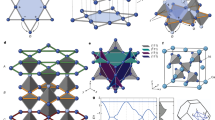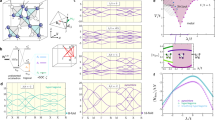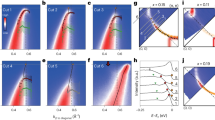Abstract
Electronic correlation effects are manifested in quantum materials when either the on-site Coulomb repulsion is large or the electron kinetic energy is small. The former is the dominant effect in cuprate superconductors and heavy-fermion systems whereas it is the latter in twisted bilayer graphene and geometrically frustrated metals. However, the simultaneous cooperation of both effects in the same quantum material remains rare. The design aim is to produce correlated topological flat bands pinned at the Fermi level. Here, we observe a flat band at the Fermi level in a 3d pyrochlore metal CuV2S4. Our angle-resolved photoemission spectroscopy data reveal that destructive quantum interference associated with the V pyrochlore sublattice and further renormalization to the Fermi level by electron interactions induce this flat band. Consequently, we discover transport signatures that evidence a deviation from Fermi liquid behaviour as well as an enhanced Sommerfeld coefficient. Our work illustrates the combined cooperation of local Coulomb interactions and geometric frustration in a pyrochlore lattice system to induce correlated topology by constructing and pinning correlated flat bands near the Fermi level.
This is a preview of subscription content, access via your institution
Access options
Access Nature and 54 other Nature Portfolio journals
Get Nature+, our best-value online-access subscription
$29.99 / 30 days
cancel any time
Subscribe to this journal
Receive 12 print issues and online access
$209.00 per year
only $17.42 per issue
Buy this article
- Purchase on Springer Link
- Instant access to full article PDF
Prices may be subject to local taxes which are calculated during checkout




Similar content being viewed by others
Data availability
All data needed to evaluate the conclusions are present in the paper and supplementary materials. Source data are provided with this paper. Additional data are available from the corresponding author on reasonable request.
Code availability
The code for the band structure calculations used in this study are available from the corresponding authors upon reasonable request.
References
Wigner, E. On the interaction of electrons in metals. Phys. Rev. 46, 1002–1011 (1934).
Dagotto, E. Correlated electrons in high-temperature superconductors. Rev. Mod. Phys. 66, 763–840 (1994).
Qazilbash, M. M. et al. Electronic correlations in the iron pnictides. Nat. Phys. 5, 647–650 (2009).
Stewart, G. R. Heavy-fermion systems. Rev. Mod. Phys. 56, 755–787 (1984).
Grüner, G. The dynamics of charge-density waves. Rev. Mod. Phys. 60, 1129–1181 (1988).
Bistritzer, R. & MacDonald, A. H. Moiré bands in twisted double-layer graphene. Proc. Natl Acad. Sci. USA 108, 12233–12237 (2011).
Cao, Y. et al. Unconventional superconductivity in magic-angle graphene superlattices. Nature 556, 43–50 (2018).
Tang, E., Mei, J. W. & Wen, X. G. High-temperature fractional quantum Hall states. Phys. Rev. Lett. 106, 236802 (2011).
Ye, L. et al. A flat band-induced correlated kagome metal. Preprint at arxiv.org/abs/2106.10824 (2021).
Song, Z.-D. & Bernevig, B. A. Magic-angle twisted bilayer graphene as a topological heavy fermion problem. Phys. Rev. Lett. 129, 047601 (2022).
Ekahana, S. A. et al. Anomalous quasiparticles in the zone center electron pocket of the kagomé ferromagnet Fe3Sn2. Preprint at arxiv.org/abs/2206.13750 (2022).
Imada, M., Fujimori, A. & Tokura, Y. Metal–insulator transitions. Rev. Mod. Phys. 70, 1039–1263 (1998).
Gurvitch, M. & Fiory, A. T. Resistivity of La1.825Sr0.175CuO4 and YBa2Cu3O7 to 1100 K: absence of saturation and its implications. Phys. Rev. Lett. 59, 1337–1340 (1987).
Si, Q., Rabello, S., Ingersent, K. & Smith, J. L. Locally critical quantum phase transitions in strongly correlated metals. Nature 413, 804–808 (2001).
Coleman, P., Pépin, C., Si, Q. & Ramazashvili, R. How do Fermi liquids get heavy and die? J. Phys. Condens. Matter 13, R723–R738 (2001).
Senthil, T., Vojta, M. & Sachdev, S. Weak magnetism and non-Fermi liquids near heavy-fermion critical points. Phys. Rev. B 69, 035111 (2004).
Sharpe, A. L. et al. Emergent ferromagnetism near three-quarters filling in twisted bilayer graphene. Science 365, 605–608 (2019).
Polshyn, H. et al. Large linear-in-temperature resistivity in twisted bilayer graphene. Nat. Phys. 15, 1011–1016 (2019).
Henley, C. L. The ‘Coulomb phase’ in frustrated systems. Annu. Rev. Condens. Matter Phys. 1, 179–210 (2010).
Regnault, N. et al. Catalogue of flat-band stoichiometric materials. Nature 603, 824–828 (2022).
Călugăru, D. et al. General construction and topological classification of crystalline flat bands. Nat. Phys. 18, 185–189 (2022).
Neves, P. M. et al. Crystal net catalog of model flat band materials. Preprint at arxiv.org/abs/2303.02524 (2023).
Ortiz, B. R. et al. New kagome prototype materials: discovery of KV3Sb5, RbV3Sb5, and CsV3Sb5. Phys. Rev. Mater. 3, 094407 (2019).
Kang, M. et al. Dirac fermions and flat bands in the ideal kagome metal FeSn. Nat. Mater. 19, 163–169 (2020).
Yin, J.-X. et al. Quantum-limit Chern topological magnetism in TbMn6Sn6. Nature 583, 533–536 (2020).
Kang, M. et al. Topological flat bands in frustrated kagome lattice CoSn. Nat. Commun. 11, 4004 (2020).
Bergman, D. L., Wu, C. & Balents, L. Band touching from real-space topology in frustrated hopping models. Phys. Rev. B 78, 125104 (2008).
Guo, H. M. & Franz, M. Three-dimensional topological insulators on the pyrochlore lattice. Phys. Rev. Lett. 103, 206805 (2009).
Huang, J. et al. Three-dimensional flat bands and Dirac cones in a pyrochlore superconductor. Preprint at arxiv.org/abs/2304.09066 (2023).
Gardner, J. S., Gingras, M. J. P. & Greedan, J. E. Magnetic pyrochlore oxides. Rev. Mod. Phys. 82, 53–107 (2010).
Ghosh, P. et al. Breathing chromium spinels: a showcase for a variety of pyrochlore Heisenberg Hamiltonians. npj Quantum Mater. 4, 63 (2019).
Hahn, H., De Lorent, C. & Harder, B. Untersuchungen über ternäre Chalkogenide. VIII. über die Struktur des CuV2S4, CuCr2S4, CuCr2Se4 und CuCr2Te4. Z. f.ür. anorganische und Allg. Chem. 283, 138–142 (1956).
Le Nagard, N., Katty, A., Collin, G., Gorochov, O. & Willig, A. Elaboration, structure cristalline et proprietes physiques (transport, susceptibilité magnétique et R.M.N.) du spinelle CuV2S4. J. Solid State Chem. 27, 267–277 (1979).
Fleming, R. M., DiSalvo, F. J., Cava, R. J. & Waszczak, J. V. Observation of charge-density waves in the cubic spinel structure CuV2S4. Phys. Rev. B 24, 2850–2853 (1981).
Okada, H., Koyama, K. & Watanabe, K. Two-step structural modulations and Fermi liquid state in spinel compound CuV2S4. J. Phys. Soc. Jpn 73, 3227–3230 (2004).
Kawaguchi, S. et al. Structural analysis of spinel compound CuV2S4 with incommensurate charge-density wave. J. Phys.: Conf. Ser. 391, 012095 (2012).
Matsuno, J., Fujimori, A., Mattheiss, L. F., Endoh, R. & Nagata, S. Photoemission and band-calculation studies of the charge-density wave in CuV2S4. Phys. Rev. B 64, 115116 (2001).
Lu, Z. W. et al. Electronic structure of CuV2S4. Phys. Rev. B 53, 9626–9633 (1996).
Georges, A., de’ Medici, L. & Mravlje, J. Strong correlations from Hund’s coupling. Annu. Rev. Condens. Matter Phys. 4, 137–178 (2013).
Misawa, T., Nakamura, K. & Imada, M. Ab initio evidence for strong correlation associated with Mott proximity in iron-based superconductors. Phys. Rev. Lett. 108, 177007 (2012).
Yu, R. & Si, Q. Orbital-selective Mott phase in multiorbital models for alkaline iron selenides K1−xFe2−ySe2. Phys. Rev. Lett. 110, 146402 (2013).
Yi, M. et al. Observation of temperature-induced crossover to an orbital-selective Mott phase in AxFe2−ySe2 (A = K, Rb) superconductors. Phys. Rev. Lett. 110, 067003 (2013).
Yi, M. et al. Observation of universal strong orbital-dependent correlation effects in iron chalcogenides. Nat. Commun. 6, 7777 (2015).
Yi, M., Zhang, Y., Shen, Z.-X. & Lu, D. Role of the orbital degree of freedom in iron-based superconductors. npj Quantum Mater. 2, 57 (2017).
Huang, J. et al. Correlation-driven electronic reconstruction in FeTe1−xSex. Commun. Phys. 5, 29 (2022).
Sun, K., Yao, H., Fradkin, E. & Kivelson, S. A. Topological insulators and nematic phases from spontaneous symmetry breaking in 2D Fermi systems with a quadratic band crossing. Phys. Rev. Lett. 103, 046811 (2009).
Butch, N. P., Jin, K., Kirshenbaum, K., Greene, R. L. & Paglione, J. Quantum critical scaling at the edge of Fermi liquid stability in a cuprate superconductor. Proc. Natl Acad. Sci. USA 109, 8440–8444 (2012).
Hagino, T., Seki, Y., Takayanagi, S., Wada, N. & Nagata, S. Electrical-resistivity and low-temperature specific-heat measurements of single crystals of thiospinel CuV2S4. Phys. Rev. B 49, 6822–6828 (1994).
Gauzzi, A., Moutaabbid, H., Klein, Y., Loupias, G. & Hardy, V. Fermi- to non-Fermi-liquid crossover and Kondo behavior in two-dimensional (Cu2/3V1/3)V2S4. J. Phys. Condens. Matter 31, 31LT01 (2019).
Chen, L. et al. Metallic quantum criticality enabled by flat bands in a kagome lattice. Preprint at arxiv.org/abs/2307.09431 (2023).
Chen, L. et al. Emergent flat band and topological Kondo semimetal driven by orbital-selective correlations. Preprint at arxiv.org/abs/2212.08017 (2022).
Hu, H. & Si, Q. Coupled topological flat and wide bands: quasiparticle formation and destruction. Sci. Adv. 9, eadg0028 (2023).
Paschen, S. & Si, Q. Quantum phases driven by strong correlations. Nat. Rev. Phys. 3, 9–26 (2020).
Zhao, H. et al. Quantum-critical phase from frustrated magnetism in a strongly correlated metal. Nat. Phys. 15, 1261–1266 (2019).
Kondo, S. et al. LiV2O4: a heavy fermion transition metal oxide. Phys. Rev. Lett. 78, 3729–3732 (1997).
Kresse, G. & Furthmüller, J. Efficient iterative schemes for ab initio total-energy calculations using a plane-wave basis set. Phys. Rev. B 54, 11169–11186 (1996).
Kresse, G. & Joubert, D. From ultrasoft pseudopotentials to the projector augmented-wave method. Phys. Rev. B 59, 1758–1775 (1999).
Perdew, J. P., Burke, K. & Ernzerhof, M. Generalized gradient approximation made simple. Phys. Rev. Lett. 77, 3865–3868 (1996).
Pizzi, G. et al. Wannier90 as a community code: new features and applications. J. Phys. Condens. Matter 32, 165902 (2020).
Yu, R. & Si, Q. U(1) slave-spin theory and its application to Mott transition in a multiorbital model for iron pnictides. Phys. Rev. B 86, 085104 (2012).
Acknowledgements
This research used the resources of the Stanford Synchrotron Radiation Lightsource, SLAC National Accelerator Laboratory, which is supported by the US Department of Energy (DOE), Office of Science, Office of Basic Energy Sciences (BES; Contract No. DE-AC02-76SF00515). The ARPES work at Rice University was supported by the Gordon and Betty Moore Foundation’s EPiQS Initiative (Grant No. GBMF9470 to M.Y.) and the Robert A. Welch Foundation (Grant No. C-2175 to M.Y.). Y.Z. is partially supported by the Air Force Office of Scientific Research (AFOSR; Grant No. FA9550-21-1-0343 to M.Y.). The theoretical work at Rice is primarily supported by the US DOE, BES (Award No. DE-SC0018197 to Q.S. for model building and microscopic calculations and support for L.C.), by the AFOSR (Grant No. FA9550-21-1-0356 to Q.S. for materials search and support for C.S.), by the Robert A. Welch Foundation (Grant No. C-1411 for model conceptualization to Q.S.) and by the Vannevar Bush Faculty Fellowship (Grant No. ONR-VB N00014-23-1-2870 for conceptualization to Q.S.). Computational modeling was supported by the Office of Naval Research Grant N00014-22-1-2753 (Y.H. and B.I.Y.). The single-crystal synthesis work at Rice was supported by US DOE BES under Grant No. DE-SC0012311 (P.D.) and by the Robert A. Welch Foundation (Grant No. C-1839 to P.D.). The transport and thermodynamic measurements at UW were supported by the AFOSR under Grant No. FA2386-21-1-4060 and the David Lucile Packard Foundation (J.H.C.). M.H. and D.L. acknowledge the support of the US DOE, BES, Division of Material Sciences and Engineering (Contract No. DE-AC02-76SF00515).
Author information
Authors and Affiliations
Contributions
M.Y. oversaw the project. C.S. and Q.S. first proposed the compound associated with the pyrochlore lattice. Single crystals were synthesized by B.G. under the guidance of P.D. J.H., Y.Z. and M.Y. carried out the ARPES measurements with the help of D.L., M.H., T.Y. and E.V. The ARPES data were analysed by J.H. The U(1) auxiliary-spin calculations were carried out by L.C., C.S. and Q.S. The DFT calculations and tight-binding model fitting were carried out by Y.H. under the guidance of B.Y. The transport and heat capacity measurements were carried out by Y.S., Z.L. and J.C. J.H. and M.Y. wrote the paper with input from all co-authors.
Corresponding authors
Ethics declarations
Competing interests
The authors declare no competing interests.
Peer review
Peer review information
Nature Physics thanks Paweł Starowicz and the other, anonymous, reviewer(s) for their contribution to the peer review of this work.
Additional information
Publisher’s note Springer Nature remains neutral with regard to jurisdictional claims in published maps and institutional affiliations.
Supplementary information
Supplementary Information
Supplementary Notes 1–8 and Figs. 1–14.
Source data
Source Data for Fig. 1
Source date for DFT calculations.
Source Data for Fig. 2
Source data for DFT calculations and ARPES EDCs.
Source Data for Fig. 3
Source data for auxiliary-spin calculations and ARPES EDCs.
Source Data for Fig. 4
Source data for resistivity and specific heat.
Rights and permissions
Springer Nature or its licensor (e.g. a society or other partner) holds exclusive rights to this article under a publishing agreement with the author(s) or other rightsholder(s); author self-archiving of the accepted manuscript version of this article is solely governed by the terms of such publishing agreement and applicable law.
About this article
Cite this article
Huang, J., Chen, L., Huang, Y. et al. Non-Fermi liquid behaviour in a correlated flat-band pyrochlore lattice. Nat. Phys. 20, 603–609 (2024). https://doi.org/10.1038/s41567-023-02362-3
Received:
Accepted:
Published:
Issue Date:
DOI: https://doi.org/10.1038/s41567-023-02362-3
This article is cited by
-
Flat bands, strange metals and the Kondo effect
Nature Reviews Materials (2024)
-
A quantum collaboration for flat bands
Nature Physics (2024)



